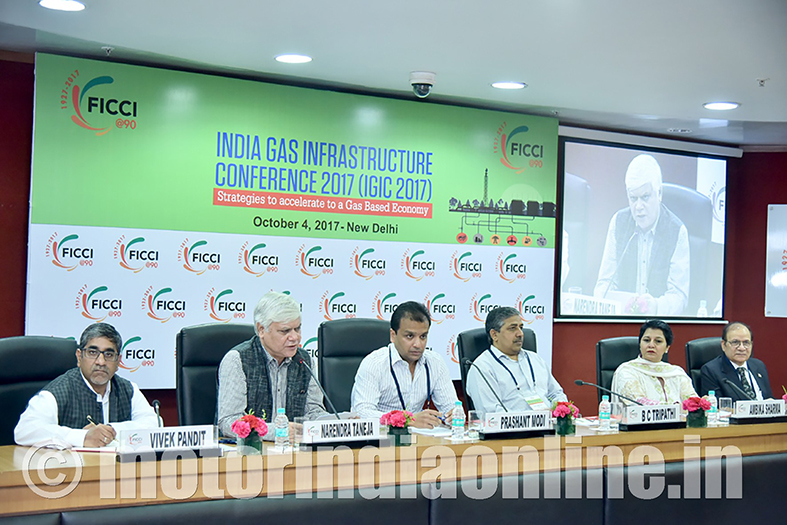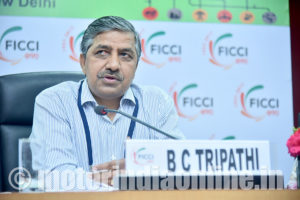India’s gas sector is crying out for an appetite for gas consumption by upstream and downstream industries and creation of a market where the benign and efficient fuel plays a peaking role and the tariff set by the regulator is in sync with the market reality.

This was stated by Mr. B.C. Tripathi, CMD, GAIL (India) Ltd., and Co-Chair, FICCI Hydrocarbons Committee, while speaking at FICCI’s India Gas Infrastructure Conference 2017 in New Delhi.
Outlining the strategies to stabilise a gas-based economy, Mr. Tripathi called for an overarching policy designed to double consumption of gas to 15% in the total energy mix of the country from the present level of 6-7%. He also underlined the need for synchronization of investment in both upstream and downstream units and ensuring that compliance is adhered to at the State level and gas is brought under the GST regime at a rate which is equal to other fuels, if not lower.
Mr. Tripathi said that the current system of regulation needs amendment. This would involve a clear-cut demarcation of functions whereby the development of pipelines would be the responsibility of the Government and setting of tariffs would be done by the regulator. Moreover, the quality of the fuel supplied should be the measure for fixation of prices and commercial contracts should be honoured resolutely. The gas economy today is demand driven. It is a benign and efficient fuel but still not received as a blockbuster fuel such as crude products.
He also stressed the need for an ecosystem where natural gas caters to all segments of the consuming industry.
On the occasion, Mr. Saurabh Chandra, former Secretary, Ministry of Petroleum & Natural Gas, and other dignitaries released the FICCI-Ceresta report on ‘India Gas Infrastructure’.
The report states that one of the fundamental requirements for building a gas-based economy is integrated planning, institutional strengthening, stable and robust regulatory structure and key policy initiatives to support investment and drive growth.

It enumerates the following specific steps and pointers on various aspects of infrastructure in order to accelerate towards a gas-based economy:
Government Policy to incentivize upstream players for increasing production from the existing, mature fields through strategies like EOR, etc. To encourage investments in EOR and enhancing production, the Government can consider suitable financial incentives and tax breaks
A more sectoral-focused gas pricing strategy with the current trend of increasing LNG usage in the country. The power sector is a case in point, wherein any strategy of gas supply must look at the entire chain to enable dispatchability of gas-based power
Alternate strategies to reach out to a larger section of gas industries and users through technologies like LNG by road, LCNG, LNG as transportation fuel, etc., which have been gaining traction worldwide
Encouraging FSRU investments given its advantage of faster implementation time, lower investment cost and flexibility. Globally, FSRUs are growing more rapidly in recent years
Making new upstream investments attractive through multiple / differential pricing methods besides marketing and pricing freedom. The Government has already announced marketing freedom and market based pricing under HELP.
A more structured planning for introducing renewable energy along with environment-friendly natural gas. The usage of such power needs to be encouraged and, where required, mandated through purchase obligations
Detailed study and phased approach to introduce gas-based power to replace diesel as back-up power in various industrial and residential clusters. Greater penetration of gas pipeline and distribution infrastructure, usage of efficient gas engines and distributed power technologies must be introduced in a planned manner
While reviewing the current authorisation procedure for CGD, the focus should be on bringing serious players into the fold. Unreasonable bidding and non-implementation of CGD due to poor economic viability have to be curbed through a well-planned and efficient mechanism of authorization
Strategies like selective Viability Gap Funding (VGF), suitable commercial intervention in the power sector and policy support to CGD development must continue in order to give the necessary momentum to the gas sector and gas-based industries
Mr. R.S. Sharma, Chairman, FICCI Hydrocarbons Committee, and former CMD, Oil and Natural Gas Corporation Ltd., Mr. Prashant Modi, immediate past President, ICC India, an allied body of FICCI, Mr. Narendra Taneja, leading energy expert and Co-Chair, FICCI Hydrocarbon Committee, and Chairman, FICCI Energy Security Group, and Ms. Ambika Sharma, Director-General, FICCI, also shared their perspectives on the subject.
The report suggests a more specific road map to be drawn up and implemented. This includes:
* A clear roadmap for accelerated development of pipeline and CGD infrastructure along with regasification terminal development on the supply side. This would require a simultaneous strategy to step up capacity utilisation through a planned gas sourcing strategy
* Utilisation of the existing gas infrastructure and creation of a national level network would need a special focus on developing domestic gas supply sources. A fair share of domestic gas supply as part of overall gas portfolio is very important in the current market scenario
* Realistic assessment of demand for various sectors is another key factor. Given the fact that LNG has taken a significant share in the overall gas portfolio and is set to increase further and with the domestic resource development taking time to develop, it would be prudent to plan the overall development, economics and usage based on a fair share of LNG in the portfolio
The report notes that in the background of current global market conditions and Indian gas markets, three important steps are necessary:
* Increased role of government in development of infrastructure through some measures of budgetary support and VGF
* Policy reforms to enable gas usage in key sectors like power through appropriate government intervention
* Overall revamp of the existing regulatory regime and creating of a more proactive regulator
Some of the specific steps suggested for the Policy and Regulatory arena are:
o Integrated planning for creation of National Gas Grid
o Standard network access code with defined principles of Third Party Access (TPA) and system integration among various operators of pipeline network
o Enabling environment for creating and operating the National gas Grid while simultaneously planning time-bound transition towards a market based pricing mechanism, unbundling and TPA / Open Access
o Review of the current process of authorisation and development of an appropriate model for authorisation and development of infrastructure. A robust structure and regulatory mechanism will effectively contribute to dispute resolution
o Overall, there is a need to introduce and sustain a consistent, reliable and transparent regulatory regime